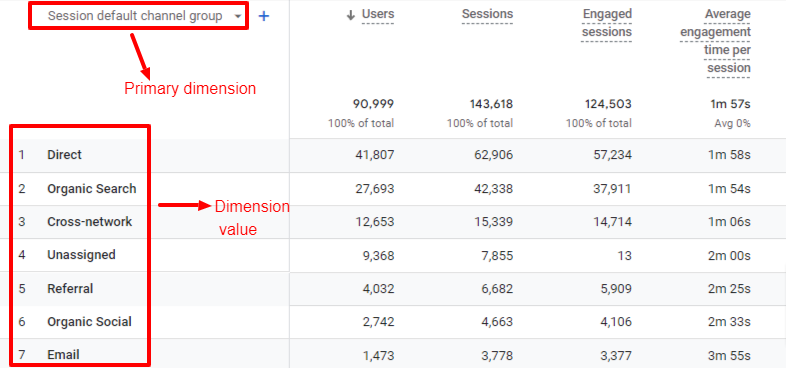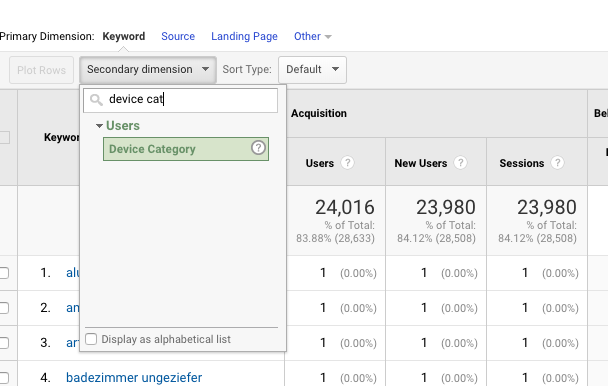Enhance Your Data Analysis with Secondary Dimension in Google Analytics
Enhance Your Data Analysis with Secondary Dimension in Google Analytics
Blog Article
Enhance Your Data Evaluation Using Secondary Measurement in Google Analytics
Exploring the capabilities of secondary dimensions in Google Analytics opens up a realm of opportunities for refining information analysis. The ability to explore details even more beyond the surface area degree offers a nuanced sight that can form calculated decisions. By layering extra measurements onto primary data sets, an even more elaborate story emerges, losing light on individual communications and performance signs. This vibrant strategy to data assessment holds the essential to unlocking surprise patterns and patterns that can transform just how companies analyze their electronic impact.
Recognizing Second Dimensions
In the realm of data analysis, a vital facet to grasp is the principle of additional measurements and their value in extracting deeper insights from Google Analytics reports. Secondary measurements in Google Analytics refer to extra parameters that can be included in the primary dimension, permitting an extra comprehensive analysis of information. By integrating second measurements, experts can sector and filter data to reveal patterns, fads, and correlations that might not be apparent when looking at the information overall. These secondary dimensions can provide context and a much more extensive understanding of individual actions, traffic resources, and various other key metrics tracked by Google Analytics.

Advantages of Using Secondary Measurements
When examining data in Google Analytics, the usage of additional measurements uses very useful understandings into individual behavior and performance metrics. By adding a second measurement to your key information, you can delve much deeper into the features of your site visitors and their interactions. Among the key advantages of utilizing second measurements is the capacity to section and contrast information extra effectively. This division enables you to comprehend how different variables, such as demographics or website traffic resources, influence individual behavior and conversions (Secondary Dimension in Google Analytics).
Furthermore, second measurements aid in recognizing patterns and connections that may not be promptly obvious when looking at the data alone. This much deeper degree of evaluation can discover important details that can guide advertising methods, internet site optimization, and total business choices. In addition, second measurements enhance the context of your primary data, providing a much more thorough view of individual interaction and efficiency metrics. Generally, the usage of secondary dimensions in Google Analytics can dramatically enhance the depth and high quality of your data evaluation, resulting in even more enlightened decision-making and improved results.
Exactly How to Add Additional Dimensions
By incorporating second measurements in Google Analytics, customers can acquire deeper understandings into their information evaluation Secondary Dimension in Google Analytics procedure, permitting for even more thorough analysis of customer habits and efficiency metrics. Including secondary dimensions is a simple procedure that can considerably boost the depth of evaluation. As soon as in the report, situate the "Additional dimension" tab over the information table.
Studying Information With Secondary Dimensions
Making use of secondary dimensions in data analysis gives an extra extensive understanding of individual habits and performance metrics. By adding a secondary dimension to your main data set in Google Analytics, you can delve deeper into the characteristics of your internet site site visitors and their interactions. For example, integrating the primary dimension of 'source/medium' with the additional dimension of 'touchdown page' can disclose which specific web pages are drawing in website traffic from different resources, aiding you maximize these pages for far better engagement.

Fundamentally, analyzing data with second dimensions encourages you to obtain important insights right into customer actions, identify patterns, and make notified choices to improve the performance of your electronic properties.
Best Practices for Secondary Dimensions
In data evaluation, integrating additional measurements efficiently can substantially boost the depth of understandings stemmed from metrics and customer actions patterns. When using secondary measurements in Google Analytics or any kind of various other analytical tool, it is critical to adhere to ideal techniques to ensure the precision and relevance of the information analysis.
One secret best method is to thoroughly select additional dimensions that match the key measurement being evaluated. Picking secondary dimensions that provide extra context or further division can provide a more comprehensive understanding of the data. It is additionally necessary to stay clear of overcomplicating the analysis by consisting of also numerous second measurements, which may bring about confusion or dilution of understandings.
In addition, it is advisable to experiment with different mixes of key and secondary measurements Get More Information to uncover brand-new connections and fads. Consistently reviewing and fine-tuning the selection of second measurements based upon the certain objectives of the analysis can result in more actionable understandings. By adhering to these finest practices, data experts can take advantage of additional dimensions successfully to enhance the overall information evaluation process and decision-making capacities.

Verdict
To conclude, including additional measurements in Google Analytics is necessary for a detailed data evaluation approach. By leveraging second dimensions alongside key ones, marketers and experts can discover useful insights and relationships continue reading this that can notify decision-making and maximize digital advertising and marketing strategies. Comprehending how to effectively make use of second dimensions and following ideal practices will enable professionals to extract meaningful data and improve their general efficiency metrics.
Additional measurements in Google Analytics refer to added criteria that can be included to the key measurement, enabling for a much more thorough analysis of information. By integrating secondary measurements, analysts can segment and filter data to uncover patterns, fads, and relationships that might not be apparent when looking at the information as a whole. Incorporating the key measurement of 'source/medium' with the secondary measurement of 'landing page' can reveal which specific web pages are bring in traffic from various resources, assisting you enhance these pages for better involvement.
One key best practice is to meticulously select additional dimensions that match the primary measurement being assessed. By complying with these best practices, data analysts can utilize secondary dimensions successfully to improve the general information evaluation process and decision-making capacities.
Report this page